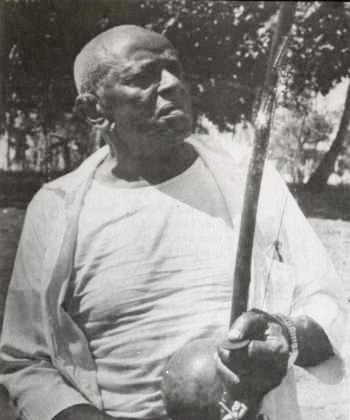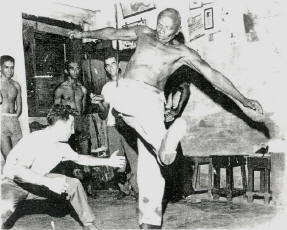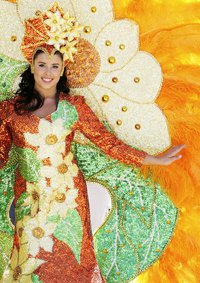History
MESTRE BIMBA’s MONTH
February @ Capoeira Filhos da Bahia School
Come & Enjoy learning “Mestre Bimba Style” CAPOEIRA REGIONAL
In commemoration of the Anniversary of his Death, we’ll be learning Mestre Bimba’s Sequences, Music & Games during FEBRUARY – from MONDAY 4th Feb – SATURDAY 16th Feb 2013!!
- Capoeira Regional Workshops, Rodas, Music & more…
- Come & Join in! Share in the ENERGY – Have fun!
So, let’s all SHARE THE BRILLIANCE of MESTRE BIMBA’s Capoeira with our friends & loved ones!
Mestre of the Month
Mestre Bimba
‘Manuel Dos Reis Machado’
November 23, 1899 – February 5, 1974
MESTRE BIMBA’s MONTH
February @ Capoeira Filhos da Bahia School
Come & Enjoy learning
“Mestre Bimba Style” CAPOEIRA REGIONAL
In commemoration of the Anniversary of his Death,
we’ll be learning Mestre Bimba’s Sequences, Music & Games
during FEBRUARY– from TUES 1st Feb – MON 28th Feb!!
SATURDAY 5th February: Mestre Bimba’s SPECIAL DAY
Capoeira Regional Workshop, Roda, Music & more…
Fun starts: 9:30am (kids class) 10:30am (adults)!
Roda 12pm | Music 1pm
Come & Join in! Share in the ENERGY – Have fun!
ALL Current CFdB students must BRING-A-BUDDY to attend the workshop (or send 1 BUDDY to participate)!
It is a FREE EVENT for all Buddies & New Beginners
So, let’s all SHARE THE BRILLIANCE of MESTRE BIMBA’s Capoeira with our friends & loved ones!
[morfeo_basic 14 /]
The son of Luiz Cândido Machado and Maria Martinha do Bonfim, Manuel dos Reis Machado known famously as Mestre Bimba was born on November 23rd, 1900, at the “Bairro do Engenho Velho” in Salvador, Brazil. The nickname “Bimba” came up due to a bet between his mother and the midwife during his birth; his mother bet that he was going to be a girl and the midwife bet he would be a boy. After he was delivered, the midwife said it’s a boy, look at his “bimba” (penis). He started learning Capoeira when he was 12 years old, with a capitão da Companhia Baiana de Navegação from Estrada das Boiadas in Salvador called Bentinho, even though, in those days, the authorities were still persecuting Capoeira. He would later be known as one half of the legendary founding fathers of contemporary Capoeira. The other would be Mestre Pastinha, the father of Capoeira Angola.
The Birth of the Regional Style
At 18, Bimba felt that Capoeira had lost all its efficiency as a martial art and resistance, becoming a folkloric activity, reduced to nine movements. It was then that Bimba started to retrieve movements from the original Capoeira fights and added movements from another African fight called Batuque – a vicious grappling type of martial art that he learned from his father, as well as introducing movements created by himself. This was the beginning of the development of Capoeira Regional.
In 1928, a new chapter in the history of Capoeira begun, as well as a change in the way black people were looked upon by the Brazilian society. After a performance at the palace of Bahia’s Governor, Juracy Magalhães, Mestre Bimba was finally successful in convincing the authorities of the cultural value of Capoeira, thus ending the official ban in the 1930’s.
Mestre Bimba founded the first Capoeira School in 1932, the Academia-escola de Capoeira Regional, at the Engenho de Brotas in Salvador, Bahia. Previously, Capoeira was only practiced and played on the streets. However, Capoeira was still heavily discriminated by upper class Brazilian society. In order to change the slyness, stealthy and malicious reputation associated with Capoeira practitioners at that time, Bimba set new standards to the art.
His students had to wear a clean, white uniform, show proof of grade proficiency from school, show good posture and many other standards. As a result, doctors, lawyers, politicians, upper middle class people, and women started to join his school, providing Bimba with better support.
Capoeira Regional is Established
In 1936, Bimba challenged fighters of any martial art style to test his Regional style. He had four matches, fighting against Vítor Benedito Lopes, Henrique Bahia, José Custódio dos Santos and Américo Ciência. Bimba won all matches.
In 1937, he earned the state board of education certificate after he was invited to demonstrate Capoeira to the President of Brazil at that time, Getúlio Dorneles Vargas.
In 1942, Mestre Bimba opened his second school at the Terreiro de Jesus – rua das Laranjeiras; today rua Francisco Muniz Barreto. The school is open until today and supervised by his former student, “Vermelho”. He also taught capoeira to the army and at the police academy. He was than considered “the father of modern Capoeira”.
Important names to the Brazilian society at that time such as Dr. Joaquim de Araújo Lima , Jaime Tavares, Rui Gouveia, Alberto Barreto, Jaime Machado, Delsimar Cavalvanti, César Sá, Decio Seabra, José Sisnando and many others were Bimba’s students.
Bimba’s Legacy
Mestre Bimba was a coalman, carpenter, warehouse man, longshoreman, horse coach conductor, but mainly Capoeirista; a giant with strong personality! Unhappy with false promises and lack of support from local authorities in Bahia, he moved to Goiânia in 1973 by invitation from a former student. He died a year later, on February 5th, 1974 at theHospital das Clínicas de Goiânia due to a stroke.
Bimba managed to recover the original values within Capoeira, which were used amongst the black slaves centuries before him. For Bimba, Capoeira was a fight but “competition” should be permanently avoided since he believed it was a “cooperation” fight, where the stronger player was always responsible for the weaker player and helped him to excel in his own fighting techniques.
Mestre Bimba fought all his life for what he strongly believed was best for Capoeira and succeeded. After he died in 1974 one of his sons, Mestre Nenel , at 14, took over his father’s Capoeira academy. Mestre Nenel is still responsible for the remarkable cultural and historical legacy his father left him and he is the President of Filhos de Bimba School of Capoeira.
Bimba’s Academy Rules
Bimba strongly believed Capoeira had an extraordinary value as a self-defence martial art, hence his efforts to develop its learning in a structured and methodical way.
Bimba developed a Capoeira teaching method with commandments, principles and traditions , which are still part of the Capoeira Regional up to this day. Some of his commandments are:
- To stop smoking and drinking since it interferes with the players’ performance
- To avoid demonstrating one’s progression as a Capoeira player outside the academy
- Avoid conversation during training, instead observe and learn from watching
- Practice daily the basic fundamentals
- Do not be afraid to come close to your opponent – the closer that you get, the more you will learn
- Keep your body relaxed
- It is better to get beat up in the roda than on the streets
Bimba also established his own Capoeira principles to fundament his Capoeira teaching method:
- “ Gingar sempre” (to Ginga always) “Ginga” is the Capoeira basic movement
- “ Esquivar sempre ” (to Esquiva always)
- All movements must have a purpose
- To preserve a constant fixed position on the ground
- To play according to the rhythm determined by the berimbau
- To respect a player when he/she can no longer defend an attack movement
- To protect the opponent’s physical and moral integrity
Consequently, Bimba created several traditions and rituals to support his methodology:
- A chair was used in order to train beginner students/players
- The “ charanga ” is the Capoeira orchestra, composed by a berimbau and two pandeiros
- The singing, songs composed by Bimba to accompany the game
- The “ batizado ”
The aspects that still makes Capoeira Regional so peculiar and outstanding is its method:
- Admission exam;
- The “ sequência ” of the basic 17 Capoeira attack and defence movements
- Practice of the different rhythms of the game
- Specific movements: traumatizing, projection, connected and unbalancing
- Practice of “ cintura desprezada ”
- “ Formatura ”
- “ Especializacdo ” and “ emboscada ”
Edval Santos – Mestre Val Boa Morte
ARGENTINA Buenos Aires
A letter from Mestre Val
ASOCIACION ARGENTINA DE CAPOEIRA
17th International Capoeira Encounter 2010
Hosted by: Mestre Marcos Gytauna – GRUPO ORIAXÉ
The event here in Buenos Aires was a great success. For me, the most special part was to share the same event with such great friends who live in different parts of the world but at the same time, are so close to each other’s Hearts (Mestre Marcos Gytauna, Mestre Amen Santo and Mestre Tonho Materia).
[portfolio_slideshow include=”877,888,889,900,902,899,890,892,893,911,914,891,912,898,894,887,897,913,921,896,910,927,928,929,930,932,933,934″]
MESTRE MARCOS GYTAUNA
Since childhood, Mestre Marcos Gytauna has been my best friend.
On January 10th, 1987, we arrived together in Argentina. We built our school and worked together until the end of 1989, which was when I left Argentina to return back to Brasil. At that time, I started touring around, all over the world until I decided to migrate to Australia. I arrived in Melbourne on November 10th, 1993.
Mestre Marcos Gytauna and I, together, we have a lot of stories – in and out of the Capoeira world – the funniest, the saddest and the happiest.
MESTRE AMEN SANTO
With Mestre Amen, we trained together at Mestre Alfredo’s School in Salvador, Bahia. We participated in many events and we did a lot of shows together.
I can’t ever forget that on my first day at Mestre Alfredo’s School, I had to play Mestre Amen. He gave me the biggest vingativa that even today, I can still hear my right elbow crack.
Anyway, we’ve always been friends. Especially now, since we’ve been inviting each other to our events since 1999, when he came to Australia for the first time.
When Mestre Amen was 17, he migrated to the USA. Before he made that decision, he was studying in his last year of secondary school. While we were walking one day, I was on my way to my Afro dance class and he was on his way to his folklore group ‘Viva Bahia’ practice, he was telling me that he was going to abandon his studies because they were giving him an opportunity to go to the USA and he was feeling that this was the opportunity of his LIFE.
The same thing happened to me and Mestre Marcos Gytauna. I invited him to come to Argentina 2 days before we left. I said that to him and with out thinking he accepted, even though in 4 days he was supposed to go to serve in the Brazilian Army. The result, already he has been here in Argentina for 23 years!
MESTRE TONHO MATERIA
With Mestre Tonho Materia, the same thing happened but he had to give up Capoeira for a while to dedicate himself to Music composition and his career as a singer. He did so well!
After training one day, I was walking with him in his neighbourhood and he said that he decided to stop Capoeira to take his music more seriously. It took him around 10 years. He never really left Capoeira because Capoeira was there with him in every stage around the world that he travelled with OLODUM and also with his solo career.
MESTRE ORELHA
I always admired that guy since he was the student of my friend, Mestre Bamba. When we trained together at Mestre Alabama’s School, in the early 90’s, I was already a Capoeira Master and he was a humble capoeirista, still a kid with so much potential. Mestre Orelha is a very smart person with so many stories to tell and a love for the Art.
So, it was good to remember all of that together in a BATE-PAPO with Mestre Marcos’ students after the OPENING RODA of the event.
Together, we remembered great capoeiristas that have already passed and many that still exist. We remembered moments in RODAS, FAMILY, FRIENDS and moments in SHOWS. You can tell by looking at the pictures and videos that we took during the whole event – We agreed, we disagreed, we cried together. It was GREAT FUN – I am glad that I came and participated in this event.
Thanks to all my friends, family and students for their support and their understanding of my need to come here to Argentina. Not only for this event but also, for the University Graduation of my Daughter, Jennifer Boa Morte Santos. Imagine, how happy I am right now, sharing that with you all.
Mestre Val Boa Morte
December 7th, 2010
[morfeo_basic 7 /]
November Agenda
MESTRE PASTINHA’S RODA
Saturday 13th November @11.30am after 10.30 class
@ Capoeira Filhos da Bahia School – 83-85 Little Oxford St. COLLINGWOOD
Everyone is Welcome
BRAZILIAN FESTIVAL
Sunday 14th November from 11am – 4pm
@ IMMIGRATION MUSEUM Old Customs House
400 Flinders Street, Melbourne
www.museumvictoria.com.au/immigrationmuseum
Capoeira Demonstration on the Main Stage starts 1.20pm – please be there 12.30pm thanks
ZUMBI DAY
‘Capoeira Fundriser and Recycle Day’
Saturday 20th November
9am – 12pm @ Filhos da Bahia School in Collingwood
9 – 10.30 – Adults and Kids Capoeira Workshops | 10.30 – 12pm Brazilian Afro Dance Class (Maculêlê, Samba de Roda, Candomble & more).
12.30pm – 1.30pm @ The Spanish Festival on Johnson Street in FITZROY
12.30 – 1pm RODA | 1pm – 1.30 FREE Capoeira Workshop to anyone.
Any DONATIONS are Welcome (Money, An old pair of Capoeira pants or T’Shirts) it all will go to CAO ‘The Capoeira Arts Organisation’ to help Cubbies Kids from our Project in Fitzroy.
It goes to any ex-student that having stopped Capoeira and have your uniform around the house
Everyone is Welcome and your all must come thanks.
A Brief History of Filhos da Bahia
Mestre Val founded the group in 1983 in Salvador, and christened it the ‘Associação de Capoeira Filhos da Bahia’ after coming back from a trip to São Paulo and Rio de Janeiro. In naming the group, he wanted to honour the name of his birth state “Bahia” and as he also wanted to represent all his brothers, friends and even his master, who grew up as children in Bahia, he came up with Filhos da Bahia (sons of Bahia).
Filhos da Bahia is represented in Brazil by Mestre Alfredo’s main school (Jequie, Bahia) and in Korea and Australia by Mestre Val ( Melbourne) and Contra-Mestre Nei Boa Morte (Sydney). Across the branches in Brazil, Korea and Australia (NSW, Northern Territory, South Australia and Victoria) the group consists of over 2.000 members.
People all over the world are discovering the rich cultural, social, energetic and personal experience that Capoeira has to offer. Filhos da Bahia is dedicated to sharing this experience with as many people as possible with the aim of presenting and teaching Capoeira and its various elements in a professional and accurate manner.
Capoeira is over 400 years old, and as with many ancient practices is handed down from generation to generation meaning there is a danger of this practice losing its essence through dilution. Mestre Val Boa Morte is committed to preserving and sharing this amazing and complex culture and energy with over 24 years of experience training, teaching and performing Capoeira all over the world.
In the last 10 years here in Australia, Filhos da Bahia Capoeira Group has being promoting a lot of great Capoeira events. With the presence of Great Capoeirista (Mestres, Professores and Students)
Filhos da Bahia represents love, honour and respect. Each of these values are instilled into our students, so that they may become better practitioners of this art form and above all, better people, allowing them personal growth. With an attitude of this sort, it is no wonder why we are Australia’s premier Capoeira Academy. Both Val and Nei Boa Morte are well known in Capoeira around the world for their skills, grace and agility in Capoeira, dance, music and aerial acrobatics. Training with Filhos da Bahia ensures that you receive professional Capoeira tuition from some of the best Capoeira practitioners in the world.
We offer you comfortable and modern training facilities within a fun and energetic environment. Come and see why more students decide to learn Capoeira with Filhos da Bahia than any other academy. And the best part of it is; you will have fun along the way.
ENERGIA DA BAHIA!!!





You must be logged in to post a comment.